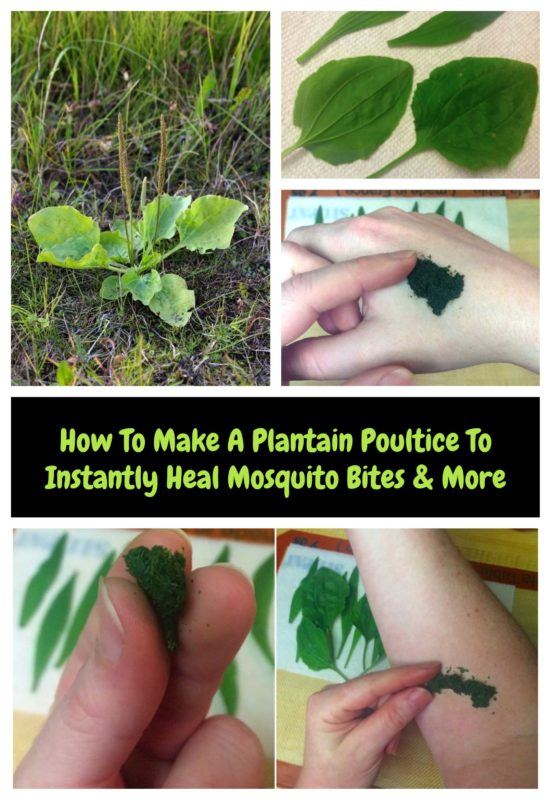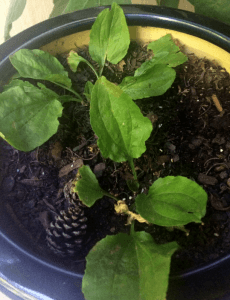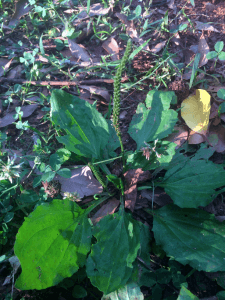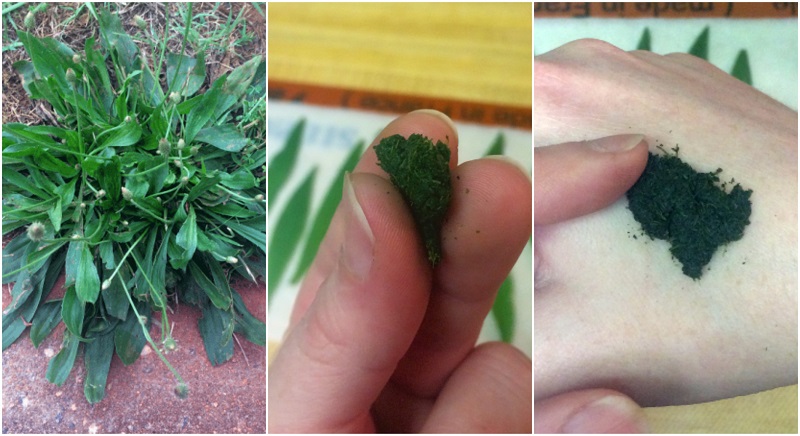
The first time I ever heard someone say to make a plantain poultice, the image of mashed up banana spread across my forearm immediately popped into my head. I knew that wasn’t what he meant, but I was far more familiar with the fruit than I was with the herb at the time.
For any of you who have worked with plantain (the herb) before, you probably already know what a powerful punch it packs in the wound-healing department. And if you’ve never tried plantain before, let me just say that you’re in for a real treat.
In the following guide, you’ll learn about the healing power of this inconspicuous little plant. Plus, we’ll go over the basics of how to identify both species of plantain which may be used to make a healing poultice. Then we’ll finish up with a step-by-step how-to guide with pictures that will walk you through the process of making a plantain poultice for the first time.
What is Plantain?
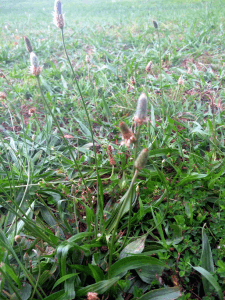
Most people are familiar with the fruit of the same name. In this case, however, we’re referring to the herb. Chances are pretty good that you’ve seen plantain growing in fields, along the edges of sidewalks or even in your own backyard – seen it, but not known what it was.
Plantain – considered to be an annoying weed by the average individual – is in fact one of the best natural healing herbs around! (You can read more about it here.)
There are two varieties which grow wild in most parts of the world: English plantain, also referred to as common plantain (Plantago major) & lance leaf plantain (Plantago lanceolata). Either species may be used to make this healing poultice.
(We will cover finding and identifying both plants later on in this guide.)
What is a Plantain Poultice Good For?
Plantain possesses many qualities which make it ideal for use in a skin healing poultice. It is a natural pain killer and anti-inflammatory. It is also naturally antiseptic and anti-viral, as well as an anti-histamine. As such, you can use plantain to heal just about any kind of skin malady including (but not limited to) mosquito bites, bee stings, poison ivy rash, infections, hemorrhoids, splinters, glass shards, boils, blisters, small cuts & scrapes, and even eczema.
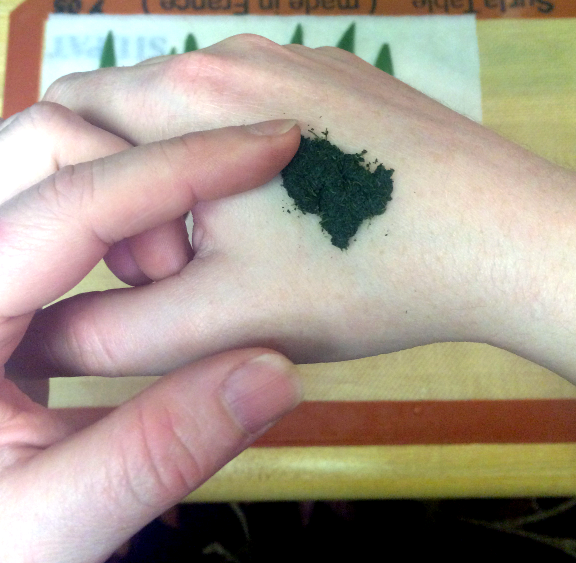
To put plantain to the ultimate test, I tried it on a small emerging patch of atopic dermatitis just as it was entering its unbearable itchy blistered stage. The results were incredible.
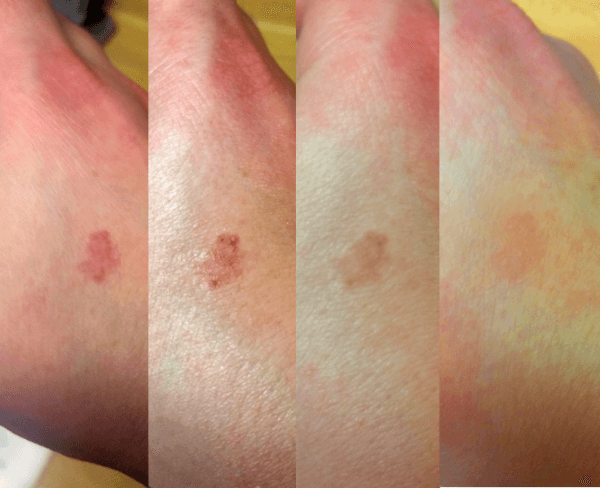
(from left to right) Atopic dermatitis progressing from its itchy blister-forming stage to almost totally healed.
The leftmost image was taken immediately before applying the first poultice. Additional pictures were taken following each two-hour application of a plantain poultice – once in the morning and once each evening before bedtime – over the course of two days.
During this experiment, the only other item applied to the affected area was organic virgin coconut oil. The oil was used after removing each poultice to prevent drying and cracking. After just one application of plantain, the emerging blisters dried up completely and stopped itching. This is the fastest I have ever seen a flare up heal, by far – faster even than using prescribed topical steroid creams! Hooray for plantain!!!
Why Use a Plantain Poultice?
So what is the point of making your own poultice, exactly? After all, it’s easy enough to just use a bandage, right?
I used to think so. Once upon a time, the triple antibiotic ointment traveled everywhere with me, tucked safely in the side pocket of my purse. But once you realize just how fast skin heals using a plantain poultice (see above) and how easy it is to find the stuff, you’ll understand.
Natural Versus Unnatural
It may be slightly easier to go to the store and buy a tube of triple antibiotic ointment than to go through the process of making a plantain poultice. And if you’ve been using the 3x ointment for all or most of your life, you know that it works so you may be loathe to switch.
However, smearing petroleum-based grease on a wound is really pretty gross when you think about it. Whereas the pretty little green gob of chewed up plantain mash looks… Well honestly, it still looks kind of gross, but at least it’s the natural kind! That, and you know that plantain is full of vitamins and minerals as opposed to chemical antibiotics which will indiscriminately kill any microbial life form (good or evil) that it comes into contact with.
Poultices Allow Skin to Breathe
Smearing greasy ointment over a cut and slapping a latex bandage over it is great for keeping contaminants out. Unfortunately, it keeps air out, too.
When applied correctly, using a plantain poultice allows wounded skin to breathe which further accelerates the healing process.
Plantain is Free
As previously stated, both species of plantain are considered weeds by most people. They grow everywhere (even in pots should you so desire) thus they are usually very easy to find. Indeed, the only part of a plantain poultice that will cost you anything is whatever you use to cover it.
It’s Non-Toxic to Everyone
Plantain is totally non-toxic to humans and pets. It is also safe to use on children. Not only is plantain non-toxic. It’s actually good for you! In fact, swallowing some of the nutrient-rich juices while chewing the plantain for your poultice is recommended in order to further improve your body’s ability to heal.
Identifying Wild Plantain
If you’ve never gone looking for plantain before, you may need a little help identifying the plant for the first time. We’ll start with English plantain (Plantago major).
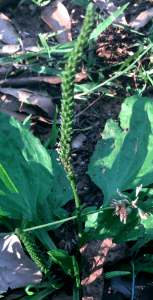
This plant looks like a cross between spinach and a miniature hosta. There is no visible stem. Leaves emerge in a rosette from the ground. English plantain grows a long flower spike from the center of the leaf rosette which bears tiny white blossoms. Blooms emerge from the bottom of the flower spike to the top. Those lower on the stalk may appear brown while flowers at the very top of the spike may have yet to open.
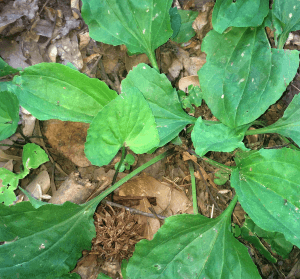
Notice the tiny white flowers emerging from the bottom of the mature flower spike of this English plantain. (left)
While Plantago major has no toxic look-alikes, beware of any imposters growing alongside or intermingled with your plantain! (right)
Lance leaf plantain (Plantago lanceolata) has long, narrow leaves and flower heads which resemble tiny cattails. Like English plantain, the lance leaf variety has no visible stem. It’s long leaves also grow in a rosette formation directly from the soil.
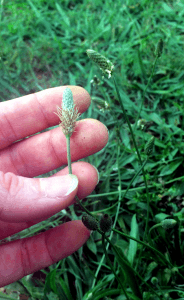 Plantago lanceolata grows flower spikes, too. Unlike those of the English variety, lance leaf plantain flower spikes are short and grow at the tip of a long stalk. These spikes may display tiny white blossoms, short white hairs, or both. Like English plantain, lance leaf flowers (and hairs) also bloom from the bottom of the spike to the top.
Plantago lanceolata grows flower spikes, too. Unlike those of the English variety, lance leaf plantain flower spikes are short and grow at the tip of a long stalk. These spikes may display tiny white blossoms, short white hairs, or both. Like English plantain, lance leaf flowers (and hairs) also bloom from the bottom of the spike to the top.
Depending on the sex of the plant, Plantago lanceolata flower spikes may display tiny white blossoms, short white hairs, or both.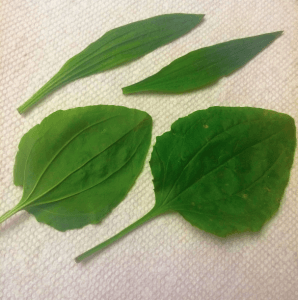
Here are top and bottom views of the leaves of Plantago lanceolata (upper) and Plantago major (lower). Notice the distinct longitudinal veins which are characteristic of both species of plantain.
Where to Find Plantain
English plantain prefers to grow in the shade of other plants. Try looking under shrubs in your garden or flower beds. You may also find it growing in the leaf litter underneath shade trees, as seen in the above images.
Lance leaf plantain loves full sun and can most often be found scattered across grassy fields or lawns. Because it loves dry compacted soil, lance leaf plantain is also commonly seen growing from cracks in sidewalks and at the edges of paved areas.
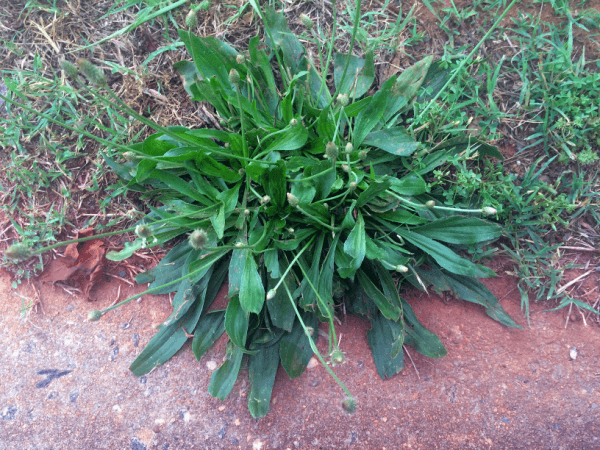
Here we see Plantago lanceolata thriving beautifully in compacted red clay right at the edge of a concrete sidewalk.
How to Make a Plantain Poultice
Now that you know a little bit about plantain and how to identify the two species used in our poultice, it’s time for the fun part! Simply follow these step-by-step instructions to make a plantain poultice that will heal just about any skin ailment faster than you ever thought was possible!
Find Some Plantain
As previously mentioned, finding plantain is usually pretty easy.
When you go hunting for yours, try to find plantain that has little chance of having been sprayed with chemical weed killers or insecticides.
The leaves of this Plantago major have obviously been snacked on by local wildlife – a good indicator that the area is free of pesticides!
Pick a Handful of Leaves
If you can, pick older larger leaves from the base of the plant. These contain more of the nutrients which make plantain so effective as a poultice.
It’s better to get too many than not enough. While the average poultice only requires 4 – 5 leaves, you may need to make more than one.
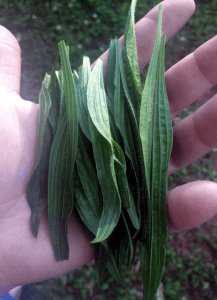 And don’t worry. Plantain is generally considered a weed because it grows fast and it’s very hard to kill. Even if you pick all of the leaves from a single plant, it can and will grow back from nothing but the roots.
And don’t worry. Plantain is generally considered a weed because it grows fast and it’s very hard to kill. Even if you pick all of the leaves from a single plant, it can and will grow back from nothing but the roots.
Also, both English and lance leaf plantain are edible and quite tasty. Should you have any leftover leaves after making your poultice, feel free to add them to your next salad!
Clean Them
Once you’ve picked your plantain, you’ll want to clean away any dirt, insects or other contaminants from the leaves. If you don’t have a source of fresh clean water available, just do the best you can to brush them off before moving on to the next step.
Mash Them
The best way to mash up your plantain leaves is to pop a few of them in your mouth (or the mouth of the person who will be receiving the poultice) and start chewing. If you like field greens, you will probably actually enjoy this part. Plantain leaves have a very potent “green” flavor with a mildly nutty undertone.
Once your leaves look and smell about like fresh wet grass clippings, you’re ready to move on to the next step.
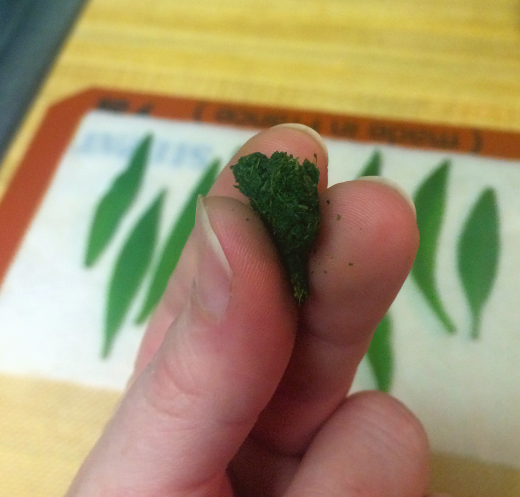
Plantain leaf mash looks and smells exactly like a gob of fresh wet grass clippings.
Apply Mashed Leaves to Skin
Apply your mashed up plantain to the mosquito bite, bee sting, cut, scrape, or whatever skin malady it is that you wish to heal. Also be sure to cover any surrounding swollen, reddish, or otherwise irritated skin. The poultice will reduce the inflammation and eliminate any itching as it dries.
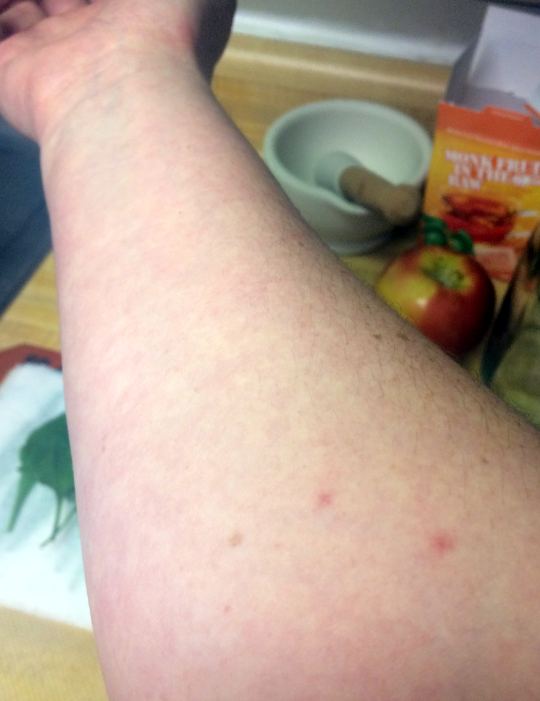
Nothing like coming in from a day of playing in the garden with a dozen itchy mosquito bites.
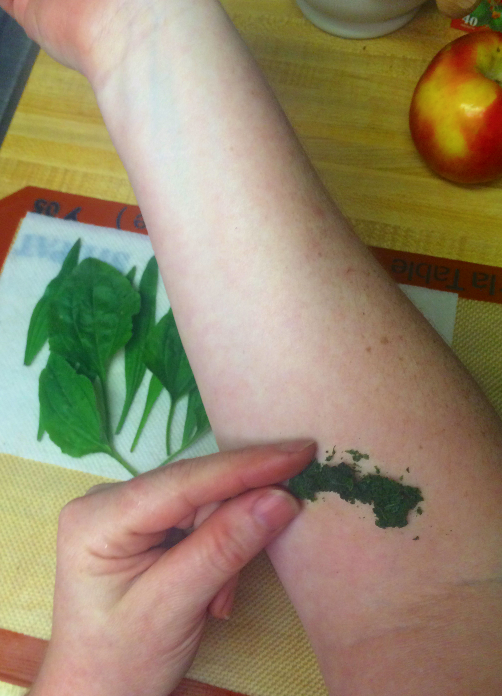
Plantain to the rescue!
Cover It Up
Use whatever you have lying around (e.g., bandages, tape, etc.) to cover the mashed plantain.
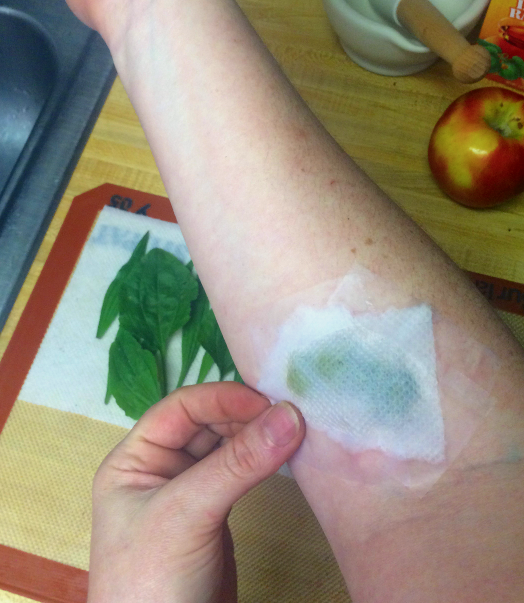
Remember, you don’t want to use anything air-tight. The poultice must be able to breathe and gradually dry in order for the ‘pulling’ action of the leaves to work.
Replace As Needed
After a couple of hours, your plantain will dry up and may need to be replaced.
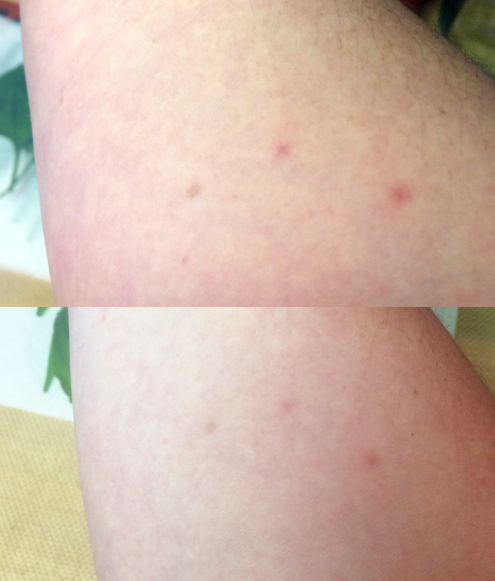
After about an hour of wearing the poultice, this is the result. The bites have noticeably faded and they no longer itch. Woohoo!
Keep An Eye On the Wound
While plantain is a very effective healing herb, you’ll still want to keep an eye on the wound. Look out for symptoms of allergic reaction such as swelling of the throat which may be life threatening. If symptoms appear, get to a doctor as quickly as possible or call the paramedics for emergency assistance.
More About Plantain and Other Healing Herbs
Once you’ve experienced the huge difference of using a plantain poultice in place of the old ointment and bandage routine, you may even decide you’d like to grow your own. It’s very easy to do. Plantain is a hardy perennial and growing it requires little effort. Just remember that both species of plantain are considered to be invasive. You’ll want to keep them contained to pots and remove the flower spikes before they produce seeds to keep the herb from rapidly propagating. Learn more about growing herbs indoors and with little effort with these 13 Indestructible Indoor Herbs Even You Can Keep Alive.
Plantain isn’t just for healing skin. Get the full scoop on this incredible herb here: Do Not Kill This Weed! It’s One Of The Best Healing Herbs On The Planet (& It’s Probably Growing Near You Right Now!)
You can use this incredible and highly underrated herbal remedy fresh, dried, or even infused in oil. Learn more about working with plantain in How to Make a Simple Healing Plantain Salve For Burns, Bites, Eczema & More
While you were out hunting for plantain, there’s a good chance you walked right past a few other edible “weeds” you never knew were good for you. Check out these 18 Edible Backyard Weeds With Extraordinary Health Benefits to learn more!
Pin This For Later
